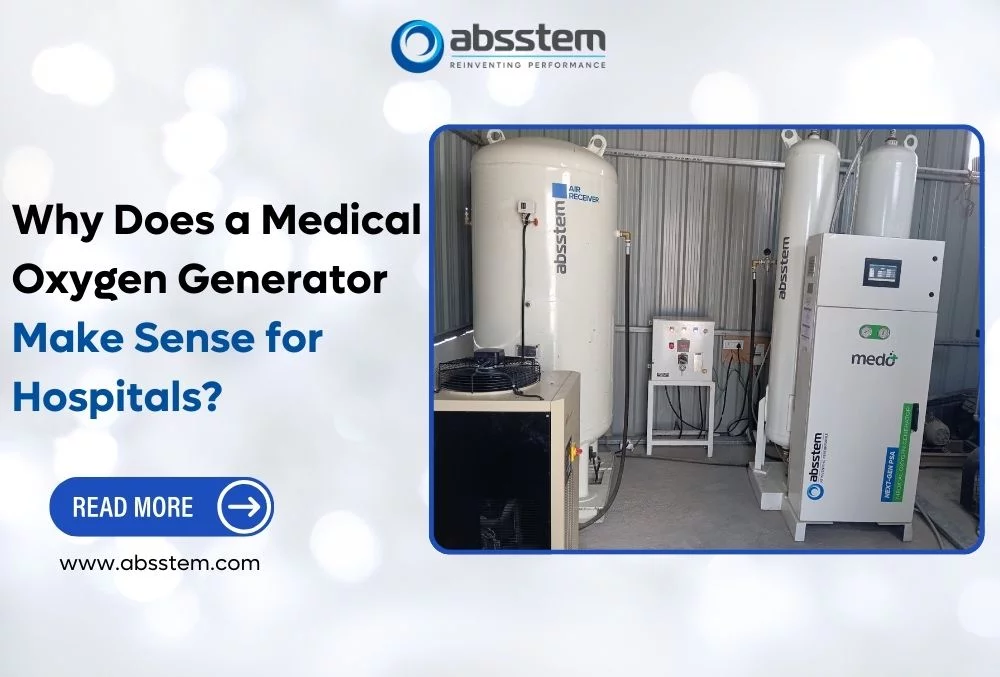Oxygen is a colourless, odourless and a tasteless gas which is very vital in the body of living organisms to burn food molecules. It is necessary in medical science as in other fields of study as well. In the case of sustaining life on the planet, oxygen cannot be overemphasized. The most basic need that human beings cannot do without is breathing. Every mammal can survive without water and food for a few days but cannot survive without oxygen. Oxygen is a gas which is used in innumerable industrial, medical and biological processes. When we are manufacturing medical oxygen generators using the finest materials for hospitals, we are often posed with numerous questions as to why it is beneficial for a hospital to invest in a medical oxygen generator. So today we are going to discuss about why medical oxygen generator makes sense for hospitals:
Reliable Oxygen Supply
A medical oxygen generator guarantees a steady source of oxygen that is also dependable. Absstem on-site oxygen generators is not like a traditional oxygen tank that has to be refilled frequently. This means that the hospitals are not confined to suppliers and can continuously provide oxygen for use in the health sector especially in emergency cases as well as the high dependency units.
Cost-Effective Solution
While the initial investment in an oxygen generator may seem significant, the long-term cost benefits are substantial. The conventional oxygen delivery systems pose continuous expenses in terms of purchasing cylinders, storing them and transportation costs. However, an on-site oxygen generator eliminates these repeat expenses by extracting oxygen from the environment, thus cutting down on the overall costs after a while. This cost-efficiency is especially beneficial for the hospitals that require a large amount of oxygen supply.
Enhanced Safety
Medical oxygen generators are safer as compared to oxygen cylinders since they do not have any hazards of pressure build-up or any need to handle high pressure oxygen cylinders. Cylinders are safety regulated and may be dangerous when not well handled. Generators are safe to use because they generate oxygen on site and thus avoid the dangers of cylinder leakage, accidental contact, and other issues. Also, they eliminate the tasks of manual lifting and moving of tough and large cylinders, which in turn improves the safety of workers.
Space and Storage Efficiency
Oxygen cylinders occupy a large space of storage and need special arrangements for handling. On the other hand, medical oxygen generators are portable and can be fitted within the existing hospital facilities. They minimize the necessity of vast storage spaces and the problems connected with them, and so the hospitals can allocate the space more efficiently for the patients’ needs and other essential tasks.
Improved Patient Care
Regular and consistent flow of medical-grade oxygen in the hospitals will improve the condition of patients with respiratory problems or those that require oxygen support. Medical oxygen generators make the oxygen therapy always available, and this enhances the quality of treatment and patients’ comfort. The capacity to deliver immediate access to oxygen can be very vital in the management of acute respiratory distress and other medical calamities.
Environmental Benefits
Medical oxygen generators are more friendly to the environment as compared to the traditional methods of using oxygen cylinders. These generators help in cutting on the amount of carbon that comes with the transportation and disposal of oxygen cylinders. This is in line with the current trend of environmental conservation in the healthcare sector and helps hospitals to achieve the desired environmental standards.
Scalability and Flexibility
Oxygen generators are flexible, or scalable, which means that the hospitals can increase or decrease their oxygen production to meet demand. In either case whether a hospital is in the process of expansion or it is facing changes in the number of patients it treats regularly, generators can be modified according to the changes. This flexibility enables the hospitals to meet regularly occurring as well as intermittent or peak demands for medical oxygen.
Reduced Dependency on External Suppliers
Dependence on outside suppliers for oxygen has its disadvantages like, supply chain constraints, and delays. An on-site oxygen generator helps to minimize such dependence and keep more oxygen under the direct control of a hospital’s management. This independence is especially useful in cases of emergency or in areas that may not have the ability to import from other suppliers.
Conclusion
Incorporating an Oxygen Generator for Hospitals operations is a strategic decision that offers numerous benefits, from ensuring a reliable oxygen supply to reducing costs and enhancing safety. Due to this need for hospitals to deliver quality health care as well as ensure they are economically productive, medical oxygen generators are seen as a worthy investment. Thus, the application of this technology can enhance the quality of the patient care delivered by hospitals, optimize the functioning of the health care organizations, and aid in achieving the goal of making the health care system more sustainable.
| Also Read:-Why PSA Oxygen Generators Are Essential for Healthcare Facilities |
References
S3 Medical Oxygen Generator Design Document for 3 Nm3/h Medical Oxygen Generation System
